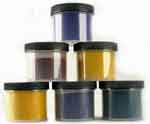How can I dye a dry-clean-only silk skirt?
Name: Judy
—ADVERTISEMENTS—
Lanaset Dyes

Lanaset Dyes are among the very best dyes for hand-dyeing wool, silk, angora, mohair, and most nylons. You will also need: citric acid, sodium acetate, Glauber salt, Albegal SET, and Synthrapol.
Buy from
Paradise Fibers
Color in Spinning
by Deb Menz
Mixing your own colors
with Lanaset dyes
Country or region: United States
Message: I have read your website, but I am feeling nervous about dyeing silk. Just wanted to make sure I use the correct method and product. Just purchased a couture Herve skirt with a long train (probably the equivalent of 4 yard of fabric) The tag only states 100% silk. The fabric is slightly see through but it isn't as sheer as silk chiffon. Currently it is dark grey and I want to dye it black. The label also states dry clean only. I don't mind having it dry cleaned. I need to know which process would be best. My dry cleaner had mentioned that silk may spot if wet with water. I have also experienced hand washing a silk item caused it to become slinky (lost body). I want to keep the body of the fabric the same and have very even color.
There's no way to get around this fact: if you can't wash it, you can't dye it! You must prewash the silk before you dye it, to remove invisible stains and finishes that will prevent good dyeing, and you will have to wash it a lot after you dye it, too, in order to remove the unattached excess dye. There is no hand dyeing process that will make washing unnecessary.
Silk is a very old fiber; the solvent-based dry cleaning system is much newer. Silk itself can tolerate water washing very well, and immersing silk all over is a good way to remove water spots. However, as you've seen before, some silk fabrics are treated with water-soluble finishing products, so that, after washing, the body and feel of the silk are different. If you're not willing to risk the body of your silk skirt, you should not even try washing it.
Even if you can wash it successfully, there is always some risk when you dye a commercial garment. Sometimes the different parts of the garment have come from different bolts of fabric, which match before you overdye them, but end up different shades after you overdye them. There's no way to predict whether or not this will happen. It's also possible that a blotch of some fabric finish, which is currently invisible, will, even after prewashing, prevent the dye from reaching the fabric evenly, resulting in a random splotch of lighter color.
Another problem with overdyeing a formal garment is that the stitching that holds the skirt together at the seams is almost invariably made from polyester, which will not take dye and will remain the original color; the contrast of the old thread color against the new fabric color may not give the look you want.
As a result, I can never recommend that anyone dye an expensive garment, even if it is washable, unless it is useless in its undyed state. There is always a real risk that you will not like the results. It's better to dye something that you won't mind losing if things don't work out. For hand-dyeing very expensive clothing, it is best to start by dyeing the unsewn yardage, and only then, after succeeding in dyeing it, arrange to have it professionally sewn into the garment you want.
(Please help support this web site. Thank you.)
Posted: Tuesday - May 03, 2011 at 08:29 AM
Follow this blog on twitter here.
Quick Links
- All About Dyes & Dyeing Top -
- Top of this blog -
- FAQ -
- The Dye Forum -
- How to Tie Dye - How to Batik -
- Books - Toys - Plants -
- Top of this blog -
- FAQ -
- The Dye Forum -
- How to Tie Dye - How to Batik -
- Books - Toys - Plants -
More in this category:
- -
Statistics
Total entries in this blog:
Total entries in this category:
Published On: Aug 29, 2012 02:49 PM
Total entries in this category:
Published On: Aug 29, 2012 02:49 PM